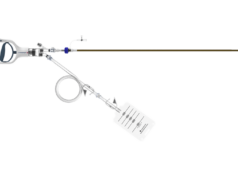
At the Royal Society of Medicine (RSM) Venous Forum meeting (25–26 June, London, UK), Alison Hopkins was asked to speak about managing painful leg ulcers. She took the opportunity to focus on the need to improve the art of compression therapy if we are to deliver successful management of leg ulcers across the UK. The contention, she argues, is that without greater understanding and successful compression therapy, patients will remain in pain despite effective medical management.
If, like me, you have been involved in community leg ulcer management for many years, you will have noted that the use of high compression therapy is frequently now defaulting to light or reduced compression bandaging. We see this through audits of care1 or analysis of bandage usage.2 There is no nationally available data on compression usage in the UK, but a recent report by Guest et al estimated that compression therapy provision can be as low as 30%.3
Compression therapy is a clinical intervention and high compression therapy produces better healing rates than no compression;4 compression therapy delivers results when a high sub-bandage pressure is delivered to the limb accompanied by a high static stiffness index.5 Unfortunately, despite nearly 30 years of education, there remains a lack of understanding about the role of this important therapeutic intervention and the art required in enabling patients to tolerate the regime. To the untrained ear, reduced or light compression sounds friendly—a kind response to a challenging situation. What would happen if we changed our language and called these reduced regimes weak, ineffectual or sub-optimal? A change in terminology may make all of us wake up to what is happening, and the subsequent harm to patients’ lives.
When compression is not applied well, is applied inconsistently or cannot be tolerated, this creates a non-therapeutic environment. It simply will not do the intended job. The result is non-healing or, even worse, uncontrolled oedema that creates maceration, skin breakdown and repeated infection. Lives are destroyed and jobs are lost. All the while, compression bandaging is being applied very neatly and repeatedly, but sadly for the patient it is weak and inadequate.
Meanwhile, healthcare professionals are frustrated with the lack of progress, the strike through, pseudomonal infections and unremitting pain for their patient. The connection between this and the ongoing delivery of sub-optimal care has not been grasped. A simple review of English FP10 prescription form data demonstrates the changing trend towards a “lite” version of compression bandage products (Graph 1) and the impact of this on an increasing spend on extra large dressing pads (Graph 2). This in turn creates an enormous workload and emotional burden for a community nursing workforce already under extreme pressure.
 What causes inadequate wound care?
What causes inadequate wound care?
We do have to question the reasons why compression therapy is applied deliberately or inadvertently at reduced compression. Before we blame the patient for requesting a lighter bandage, let us look first at ourselves and the culture we work within.
Leg ulcer management within the community is left largely to tissue viability nurses and community nursing. There are few medical practitioners that work within a community or primary care context. Thus the local guidelines are seen as the decisive framework for directing care. Like the Scottish Intercollegiate Guidelines Network (SIGN)4 or National Institute of Health and Care Excellence (NICE) guidelines, unfortunately there is no Plan B if the patient fails to progress or cannot tolerate the therapy. Even in circumstances where the guidelines have been used to the letter, and progress has not been made, specialist nurses are reluctant to challenge the standardised advice. There is an increasing culture of risk adverse nursing, even in the face of failing care.
However, our tissue viability colleagues across the country have been inundated by the workload associated with pressure ulcer management, prevention and reporting. Leg ulcer management has taken a back seat, an unintended consequence of such an important focus. Meanwhile, community nursing is experiencing unprecedented vacancy rates.
Four steps towards improving compression care
There are some simple but bold steps that need to be taken.
- Ensure pain is managed effectively prior to commencing compression therapy. If the bandage or technique used increases the pain, then no one should expect the patient to keep it on. Ulceration is painful and, inadequately managed, pain is often accompanied by neuropathic pain.
- Ensure that the compression bandage delivers healing and provides a therapeutic intervention: healing and exudate reduction must be evident. If it is not, review whether compression therapy is at the most appropriate level, as well as whether it is consistent and comfortable. The need for daily bandage changes and recurrent infection point to inadequate compression that is not managing the oedema.
- Standard care is great—for standard patients. If they are tall, they may require a higher level of working pressure;2 the UK guidance views 35mmHg at the ankle as high compression whilst this has been described as moderate by an International Consensus document.4 Likewise, the site of the ulcer needs consideration. The retromalleolar area receives very little direct compression thus a technique of compression strapping has been found useful.6
- If the bandage is not comfortable, ask the patient what will make the difference. They need to understand the aim of the therapy and what you are trying to achieve. They need confidence in such difficult treatment. They may also point out that with Nurse X they can tolerate the bandage, but dread Nurse Y walking through their door. This is a common issue and needs to be managed sensitively, but ultimately they need to be in receipt of good care for their ulcer to heal.
We have to appreciate that compression bandaging in the right hands is an art. Put this together with knowledge, skill and empathy, it becomes a potent therapy that needs to be optimised.4 This therapeutic intervention is so much more than a task, and cannot be left to the untrained. Compression bandaging or hosiery remains the cornerstone of effective treatment; if it is not working, we must ask why, and be prepared to be creative. One size does not fit all.
Nevertheless, change is afoot. NHS England is embarking on a Wound Care Strategy that recognises leg ulceration as one of the biggest unmet health needs and a considerable cost to the economy and patients’ lives. The Legs Matter campaign launched in April 2018, as a coalition aiming to raise the awareness and expectation of patients.
We all have our part to play in ensuring patients get the care they need. If not, is this not harm?
Alison Hopkins is a nurse specialised in wound care, as well as the chief executive officer at UK-based Accelerate CIC, a social enterprise working within the NHS to provide specialist care for chronic wounds and lymphoedema patients. Hopkins has been awarded a Member of the Most Excellent Order of the British Empire (MBE) for her services to nursing.
References
- King BM. Leg ulcer audit report. Leg Ulcer Forum J 2016;28:16-9.
- Guest JF et al. Health Economic burden that wounds impose on the National Health Service in the UK. BMJ Open 2015;5
- Hopkins A, Bull R and Worboys F, 2017 Veins and Lymphatics 2017; https://www.pagepressjournals.org/index.php/vl/article/view/6630/6336
- Scottish Intercollegiate Guidelines Network (SIGN). Management of chronic venous leg ulcers. Clinical guideline No. 120. Scottish Intercollegiate Guidelines Network; 2010. Available from: www.sign.ac.uk
- World Union of Wound Healing Societies (WUWHS). Principles of best practice: compression in venous leg ulcers. A consensus document. London: MEP Ltd.; 2008. Available from: http://www.woundsinternational.com/media/issues/65/files/content_25.pdf
- Hopkins A, Worboys F, Partsch H (2013) Using strapping to increase local pressure. Veins and Lymphatics. Vol 2,12 https://www.pagepressjournals.org/index.php/vl/article/view/vl.2013.e12/pdf













How does a good Abpi but severe peripheral neuropathy work with Compression ?